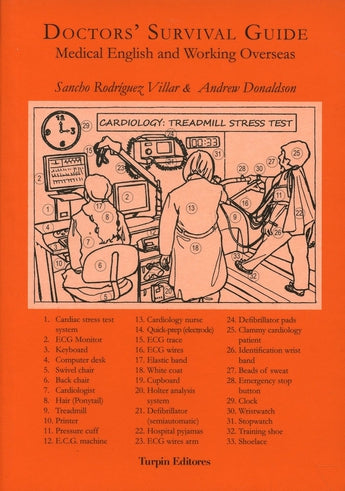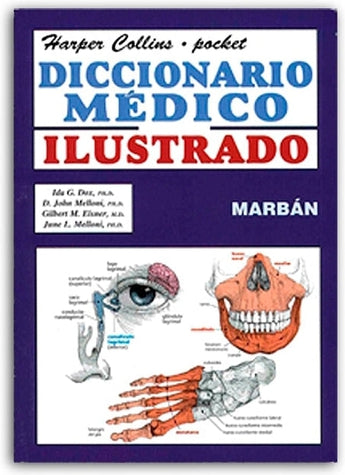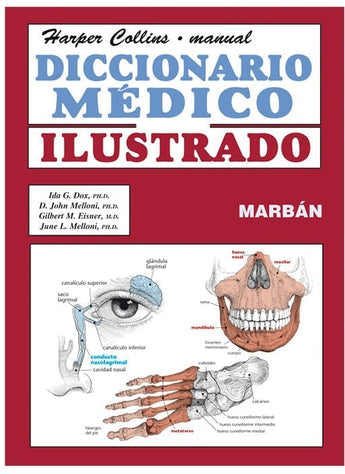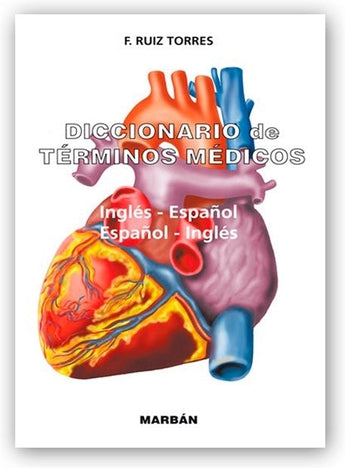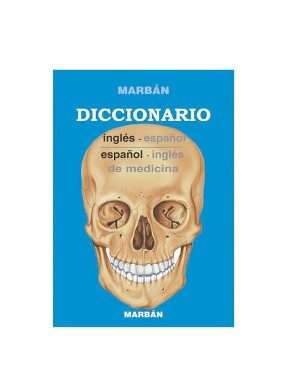Medical and Scientific English
En la era de la globalización, el inglés se ha establecido como un idioma indispensable y predominante en la comunicación científica y médica a nivel internacional. Gran parte de las investigaciones, estudios y actualización de protocolos se publican en inglés, por lo que dominar la lengua permitirá a los profesionales mantenerse actualizados con los últimos avances y prácticas en su campo.
-
Es un recurso nuevo para enseñar y aprender inglés con el fin de aplicarlo en un entorno médico.
-
Contiene 13 unidades didácticas, cada una de ellas enfocada en una especialidad médica. Las unidades incluyen una serie de actividades para reforzar el aprendizaje del idioma.
-
Posee un atlas visual del cuerpo humano con las estructuras anatómicas en inglés.
-
La versión digital cuenta con las pistas de audio en inglés referidas a las actividades y una serie de ejercicios adicionales.
-
Permite el acceso a la plataforma Voicebooks, una herramienta complementaria para mejorar las habilidades de escucha y comprensión en inglés.
La versión digital de esta publicación incluye material complementario que facilitará la comprensión del contenido de la obra.
- Audios que ayudan al estudiante a desarrollar sus habilidades en la escucha del inglés médico y que están relacionados con:
- Ejercicios propios de las lecciones.
- Ejercicios para la preparación de exámenes oficiales de Cambridge Assessment English.
- Ejercicios adicionales a los incluidos en la obra impresa, y sus soluciones.
- Acceso a Voicebooks : plataforma con 13 unidades alineadas con el contenido teórico del libro. Escucha una frase, escribe en la plataforma lo que entiendas y la plataforma te ayudará a reconstruir la oración completa palabra por palabra. De esta forma evaluarás tus habilidades de escucha y descodificación de las palabras.
ÍNDICE:
UNIT 1 MEDICAL LANGUAGE AND INTRODUCTION TO THE HUMAN BODY
LESSON 1 Welcome to medical English!
- The history of medical English
- Communicating with patients in English
- Spelling
- Pronunciation
LESSON 2 Word structure in medical English
- Word structure in medical English
- Word roots
- Prefixes
- Suffixes
- Combining words
- Abbreviations
- EXERCISES Lesson 1
- Lesson 2
LESSON 3 Talking about the body
- Introduction
- Body planes and directions
- Frontal or Coronal plane
- Sagittal plane
- Transverse plane
- Other body directions
- Body quadrants
- Body cavities
LESSON 4 Medical specialties
- Medical specialties
- Orthopaedics
- Dentistry
- Pulmonology
- Cardiology
- Gastroenterology
- Dermatology
- Haematology
- Immunology
- Neurology
- Endocrinology
- Andrology
- Gynaecology and Obstetrics
- Ophthalmology
- Otolaryngology
- EXERCISES Lesson 3
- Lesson 4
UNIT 2 ORTHOPAEDICS (I): THE SKELETAR SYSTEM
LESSON 1 The anatomy of the skeletal system – the axial skeleton
- Introduction
- The skull
- The bones of the chest
- Bones of the back
LESSON 2 The anatomy of the skeletal system – the appendicular skeleton
- Pectoral girdle – bones of the shoulders
- Upper Extremities
- Upper and lower arm
- Bones of the wrist, hand and fingers
- Bones of the hips
- Bones of the lower extremities
- Upper and lower leg
- Ankles, feet and toes
- Physiology of bone growth
- EXERCISES Lesson 1
- Lesson 2
LESSON 3 The most common diseases and disorders of the skeletal system
- The main diseases of the bones and skeleton
- Diseases of the vertebrae
- Diseases of the joints (arthropathy) and ligaments
- Arthritis
LESSON 4 The main diagnostic procedures and treatment of the skeletal system
- Laboratory and diagnostic procedures
- Blood tests
- Imaging tests
- Medical procedures
- EXERCISES Lesson 3
- Lesson 4
UNIT 3 ORTHOPAEDICS (II): THE MUSCULAR SYSTEM
LESSON 1 The anatomy of the muscular system (Part 1)
- Types of muscles
- Naming of the skeletal muscles
- Origins and insertions
- Joints
- Muscle movement
LESSON 2 The anatomy of the muscular system (Part 2)
- Muscles of the head and neck
- Muscles of the shoulder, chest and back
- Muscles of the upper extremity – arms and hands
- Muscles of the abdomen
- Muscles of the Lower Extremity – Legs and Feet
- Physiology of muscle contraction
- EXERCISES Lesson 1
- Lesson 2
LESSON 3 The main diseases and disorders of the muscular system
- The most common diseases of the muscles
- Movement disorders
LESSON 4 The main diagnostic procedures and treatment
- The most common laboratory and diagnostic procedures
- Blood tests
- Muscle tests
- The most common medical procedures
- Braces and adaptive devices
- Deep tendon reflexes (DTR)
- Muscle strength test
- Rehabilitation exercises
- Trigger point injections
- Surgical procedures
- EXERCISES Lesson 3
- Lesson 4
UNIT 4 ODONTOLOGY AND DENTISTRY
LESSON 1 Dental anatomy and physiology
- The oral cavity
- The teeth
LESSON 2 Dental charting
- Introduction
- Names of teeth
- Dentition
- Dental arches
- Tooth numbering systems
- Tooth surfaces
- Morphology of teeth
- Occlusion
- EXERCISES Lesson 1
- Lesson 2
LESSON 3 Dental instruments
- Introduction
- Hand cutting instruments
- Amalgam carriers, condensers, plastic filling instruments, carvers and burnishers
- Dental handpieces and rotary instruments
LESSON 4 Dental caries and periodontal disease
- Dental caries
- Restoration/filling procedure
- Periodontal disease
- Other forms of periodontal disease
- EXERCISES Lesson 3
- Lesson 4
UNIT 5 PULMONOLOGY AND THE RESPIRATORY SYSTEM
LESSON 1 The lungs and the respiratory system
- The anatomy of the upper respiratory system
- The nose and nasal cavity
- Pharynx
- Larynx
- The anatomy of the lower respiratory system
- Trachea
- Bronchi
- Alveoli
- The lungs
LESSON 2 Physiology of respiration
- Introduction
- Respiration
- The processes of respiration
- Respiratory rate
- EXERCISES
- Lesson 1
- Lesson 2
LESSON 3 The main diseases of the respiratory system
- Introduction
- Diseases of the upper respiratory system
- Diseases of bronchial tubes
- Diseases of the lungs
LESSON 4 The main diagnostic procedures and treatment
- Diagnostic procedures
- EXERCISES Lesson 3
- Lesson 4
UNIT 6 CARDIOLOGY AND THE VASCULAR SYSTEM
LESSON 1 The heart and the cardiovascular system
- Introduction
- The anatomy of the heart
- The cardiovascular system
- The wall of the heart
LESSON 2 Blood vessels
- Introduction
- Arteries, capillaries and veins
- EXERCISES Lesson 1
- Lesson 2
LESSON 3 Circulation of the blood and physiology of the heart
- Systemic circulation
- Pulmonary circulation
- Alveoli
- The beating heart: blood pressure
- How does the heart pump?
- The main cardiovascular diseases, diagnostic procedures and treatment
- Introduction
- Diagnosis
- Treatment for cardiovascular diseases
- EXERCISES Lesson 3
- Lesson 4
UNIT 7 GASTROENTEROLOGY AND THE DIGESTIVE SYSTEM
LESSON 1 The anatomy and physiology of the upper gastrointestinal system
- Introduction
- The upper gastrointestinal system
LESSON 2 The anatomy and physiology of the lower gastrointestinal system
- The small intestine
- The large intestine
- Accessory organs of the digestive system
- EXERCISES Lesson 1
- Lesson 2
LESSON 3 The main diseases of the digestive system
- Diseases and disorders
- Pharynx and oesophagus
- Stomach
- Small and large intestines
- Inflammatory bowel disease (IBD)
- Accessory Organs
LESSON 4 The main diagnostic procedures and treatment
- Diagnostic procedures
- Blood tests
- Gastric and fecal specimen tests
- Diagnostic tests
- X-ray exams and imaging
- Main therapeutic and surgical procedures
- EXERCISES Lesson 3
- Lesson 4
UNIT 8 DERMATOLOGY AND THE INTEGUMENTARY SYSTEM
LESSON 1 The integumentary system
- Introduction
- The layers of the skin
- Epidermis
- Dermis
- Hypodermis
LESSON 2 Accessory structures of the skin
- Introduction
- Hair
- Nails
- Sebaceous (oil) glands
- Sweat glands
- EXERCISES Lesson 1
- Lesson 2
LESSON 3 The main cutaneous diseases
- Introduction
- The most common contagious diseases
LESSON 4 The main diagnostic procedures and treatment
- Introduction
- Diagnostic procedures
- Culture and sensitivity test (C&S)
- Biopsy
- Wood’s Lamp
- Scratch (epicutaneous) or Prick Test
- Sweat Test
- Medical and surgical procedures
- Aesthetic procedures
- Blepharoplasty
- Botox injections
- Dermal fillers
- Liposuction
- Skin resurfacing techniques
- Rhytidectomy
- EXERCISES Lesson 3
- Lesson 4
UNIT 9 HAEMATOLOGY AND INMUNOLOGY
LESSON 1 The anatomy of blood
- Introduction
- Blood
- Plasma
- The formed elements
- Blood types
LESSON 2 The lymphatic and immune systems
- The lymphatic system
- Lymph or lymphatic fluid
- LymPhatic vessels
- Lymphoid tissues – cells and organs
- The immune system and immune response
- EXERCISES Lesson 1
- Lesson 2
LESSON 3 The main diseases of the blood and lymphatic system
- The most common diseases of the blood
- Anaemia
- Deep vein thrombosis (DVT)
- Haemophilia
- Leukaemia
- Mononucleosis
- Multiple myeloma
- Polycythemia vera
- Thallassemia
- Transfusion reaction
- The most common diseases of the lymphatic system
- Graft-versus-host disease (GVHD)
- Lymphadenopathy
- Lymphoedema
- Lymphoma
- Thymoma
- Vasculitis
- The most common immune disorders
LESSON 4 The main diagnostic procedures and treatment
- Introduction
- Blood tests
- Blood type
- Blood culture and sensitivity (C&S)
- Complete blood count (CBC)
- Erythrocyte sedimentation rate (ESR, SR, Sed rate)
- Peripheral blood smear
- Coagulation tests
- Serum tests
- Urine tests
- Other blood tests
- Diagnostic Imaging
- The most common medical procedures
- The most common surgical procedures
- EXERCISES Lesson 3
- Lesson 4
UNIT 10 NEUROLOGY AND THE NERVOUS SYSTEM
LESSON 1 The Anatomy of the Central and Peripheral Nervous Systems
- Introduction
- The Anatomy of the Central Nervous System (CNS)
- The Brain
- The Spinal Cord
- The Peripheral Nervous System (PNS)
- The Somatic Nervous System
- The Autonomic Nervous System
LESSON 2 Physiology of a Neuron and Neuron Transmitters
- Nervous Tissue
- EXERCISES Lesson 1
- Lesson 2
LESSON 3 The Most Common Diseases of the Nervous System
- The Main Neurological Diseases and Disorders
- Amnesia
- Aphasia
- Arteriovenous Malformation (AVM)
- Brain Tumor
- Cephalalgia
- Cerebral Palsy
- Cerebrovascular Accident (CVA)
- Coma
- Concussion
- Dementia
- Encephalitis
- Epilepsy
- Huntington’s Disease
- Meningitis
- Parkinson’s Disease
- Spinal Cord Injury
- Multiple Sclerosis
LESSON 4 The Main Diagnostic Procedures and Treatment
- Introduction
- Laboratory Tests
- Cerebrospinal Fluid Examination (CFS)
- Imaging Tests
- Cerebral Angiography
- Computed Axial Tomography (CAT, CT)
- Doppler Ultrasonography
- Magnetic Resonance Imaging (MRI)
- Myelography
- Positron Emission Tomography Scan (PET)
- Skull X-ray
- Other Diagnostic Tests
- Electro Encephalography (EEG)
- Evoked Potential Testing
- Nerve Conduction Study
- The Most Common Medical and Surgical Procedures
- Babinski’s Sign
- Glasgow Coma Scale
- Lumbar Puncture
- Mini-Mental Status Examination (MMSE)
- Neurologic Examination
- Spinal Traction
- Transcutaneous Electrical Nerve Stimulation (TENS) Unit
- Specific Surgical Procedures
- Carotid Endarterectomy
- Discectomy
- Stereotactic Neurosurgery
- Ventriculoperitoneal Shunt
- EXERCISES Lesson 3
- Lesson 4
UNIT 11 ENDOCRINOLOGY AND THE ENDOCRINE SYSTEM
LESSON 1 The Anatomy of the Endocrine System
- Introduction
- The Anatomy of the Endocrine System
- Hypothalamus
- Pituitary Gland
- Pineal Gland
- Thyroid Gland
- Parathyroid Glands
- Thymus Gland
- Pancreas
- Adrenal Glands
- Ovaries
- Testes
LESSON 2 Physiology of Hormones
- Hormone Response and Feedback
- EXERCISES Lesson 1
- Lesson 2
LESSON 3 The Main Diseases and Disorders
- of the Endocrine System
- Introduction
- Hyperadrenalism and Hypoadrenalism
- Hypercalcemia and Hypocalcemia
- Hyperthyroidism
- Hypothyroidism
- Pancreatitis
- Pituitary Gigantism
LESSON 4 The Main Diagnostic Procedures
- and Treatment
- Laboratory and Diagnostic Procedures
- Blood Tests
- Urine Tests
- Imaging Tests
- EXERCISES Lesson 3
- Lesson 4
UNIT 12 ANDROLOGY, GYNAECOLOGY, AND OBSTETRICS
LESSON 1 The Anatomy and Physiology of the Male Reproductive System
- Introduction
- External Organs
- Internal Organs
- Physiology of Spermatogenesis and Ejaculation
- Spermatogenesis
- Ejaculation
LESSON 2 The Anatomy and Physiology of the Female Reproductive System
- Introduction
- Internal Organs
- External Genitalia
- Menstrual Cycle
- Pregnancy
- Labour and Delivery
- EXERCISES Lesson 1
- Lesson 2
LESSON 3 The Main Diseases and Disorders of the Male Reproductive System, Diagnostic Procedures and Treatment
- Introduction
- Testes and Epididymis
- Prostate
- Penis
- Sexually Transmitted Diseases (STD)
- The Most Common Laboratory and Diagnostic Procedures
- Blood Tests
- Semen Tests
- Diagnostic Imagery
LESSON 4 The Main Diseases and Disorders of the Female Reproductive System, Diagnostic Procedures and Treatment
- Ovaries and Uterine Tubes
- Menstrual Disorders
- Cervix
- Vaginal Infections
- Breasts
- Sexually Transmitted Disease (STD)
- Pregnancy, Labour and Delivery
- During Pregnancy
- During Labour and Delivery
- The Most Common Laboratory and Diagnostic Procedures
- Gynaecological Tests
- Diagnostic Imagery
- EXERCISES Lesson 3
- Lesson 4
UNIT 13 OPHTHALMOLOGY AND OTOLARYNGOLOGY
LESSON 1 The Anatomy and Physiology of the Eye
- Introduction
- The Anatomy of the Eye
- Physiology of Vision
LESSON 2 The Anatomy and Physiology of the Ear
- Introduction
- Anatomy of the Auditory System
- Vestibule and Semicircular Canals
- Cochlea
- Physiology of the Sense of Hearing
- EXERCISES Lesson 1
- Lesson 2
LESSON 3 Diseases, Disorders, Diagnostic Procedures and Treatment in Ophthalmology
- Refractive Disorders
- Inflammation and Infection
- Pathologies
LESSON 4 Diseases, Disorders, Diagnostic Procedures and Treatment in Otolaryngology
- The Main Diseases and Disorders of the Ear
- Hearing Loss
- The Main Diagnostic and Surgical Procedures
- Diagnostic Tests
- EXERCISES Lesson 3
- Lesson 4
Características
Características
Título: Medical and Scientific English
ISBN: 9788411062787
Autor: D'Andria . Gralton
Editorial: Panamericana
Edición: 1ª - 2024
Idioma: Español / inglés
Impresión: Color
Dimensiones: 20 cm x 26 cm
Encuadernación: Flexilibro
Páginas: 269
Peso: 0.6kg
Envíos
Envíos
Política de envío
Los envíos de las compras realizadas a través de la tienda online www.marbanlibros.com, se realizarán con diferentes empresas de transporte dependiendo del destino indicado por el cliente:
- España Peninsular, Baleares y Portugal: envíos a través de Tip-SA con un plazo de entrega de 24h Envíos con CorreosExpress con un plazo de entrega de 24-48h. Gastos de envío gratuitos.
-
Islas Canarias, Ceuta y Melilla: envíos a través de Correos. El plazo de entrega suele estar comprendido entre 7 a 10 días.
Gastos de envío variables en función del peso total del pedido:
- Hasta 20 gr.: 4,15€ de gastos de envío
- Entre 20 y 50 gr.: 4,25€ de gastos de envío.
- Entre 50 y 100 gr.: 4,70€ de gastos de envío.
- Entre 100 y 500 gr.: 5,95€ de gastos de envío.
- Entre 500 gr. y 1 kg.: 8,60€ de gastos de envío.
- Entre 1 y 2 kg.: 9,05€ de gastos de envío.
- Entre 2 y 5 kg.: 18,35€ de gastos de envío.
- Entre 5 y 10 kg.: 21,85€ de gastos de envío.
- Entre 10 y 15 kg.: 31,65€ de gastos de envío.
- Entre 15 y 20 kg.: 38,15€ de gastos de envío. - Otros países:
- envíos a través de Correos Express Internacional. El plazo de entrega suele estar comprendido entre 7 a 10 días. Gastos de envío variables en función del país y del peso total del pedido. Puede estimarse el coste introduciendo los datos de la dirección de envío tras añadir productos al carrito de compra. Los gastos aduaneros, si los hubiera, correrán a cargo del cliente.
- envíos a través de Asendia. Este servicio realiza envíos por Correo Postal. El plazo de entrega oscila, según el país de destino, entre 7 y 18 días*. Los gastos de envío son variables en función del país y peso total del pedido.
* Por la stuación actual de Pandemia motivada por el COVID-19, los tiempos de envío internacionales son mayores, dependiendo del estado de apertura de las fronteras comerciales de cada país.
ENVÍOS LATAM:
Marbán Libros S.L. podrá enviar a estas localizaciones siempre y cuando sean artículos / libros de la editorial Marbán.
Envíos por Asendia
Lista de países:
- ARGENTINA**
- BOLIVIA**
- BRASIL**
- CHILE**
- COLOMBIA**
- COSTA RICA**
- CUBA*
- DOMINICA*
- EL SALVADOR*
- GUATEMALA**
- HAITÍ*
- HONDURAS*
- JAMAICA**
- NICARAGUA*
- PANAMÁ**
- PARAGUAY**
- PERÚ**
- PUERTO RICO**
- REP. DOMINICANA**
- URUGUAY**
- VENEZUELA*
* Países donde el envío puede ser hasta 2Kg
** Países donde el envío puede ser hasta 20Kg
Envíos por Correos Express Internacional
- ARGENTINA
- BOLIVIA
- BRASIL
- CHILE
- COLOMBIA
- COSTA RICA
- CUBA
- ECUADOR
- EL SALVADOR
- GUATEMALA
- HAITÍ
- HONDURAS
- JAMAICA
- NICARAGUA
- PANAMÁ
- PARAGUAY
- PERÚ
- REP. DOMINICANA
- URUGUAY
- VENEZUELA
Países donde el envío puede ser hasta 20Kg
El plazo de entrega comienza una vez se haya confirmado la disponibilidad de la mercancía y comprobado el pago completo del pedido. Puede variar según la forma de pago elegida por el cliente.
El Prestador no asumirá ninguna responsabilidad cuando la entrega del producto o servicio no llegue a realizarse, por ser los datos facilitados por el usuario, falsos, inexactos o incompletos.
La entrega se considerará realizada en el momento en que el transportista haya puesto los productos a disposición del usuario y éste, o el delegado de éste, haya firmado el documento de recepción de la entrega.
Corresponde al Usuario verificar los productos a la recepción y exponer todas las salvedades y reclamaciones que puedan estar justificadas en el documento de recepción de la entrega.
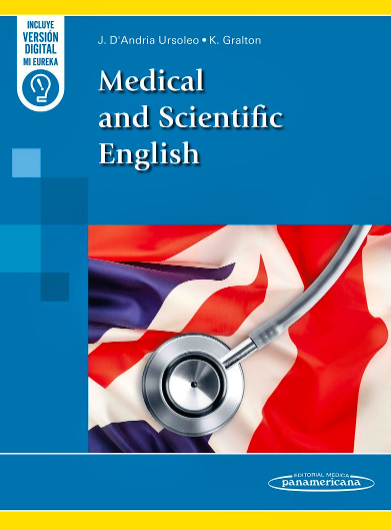
- Al seleccionar una opción, se actualiza toda la página.


